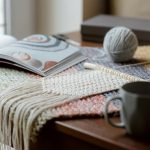Do you know what you can do with wool fabric?
From clothing to home decor, outdoor gear to crafting projects, wool has a wide range of uses.
It’s a versatile material that offers insulation, thermal regulation, and even medical applications.
In this article, we’ll explore the various ways you can utilize wool fabric in your everyday life.
So, grab a cup of tea and get ready to discover the many uses of this remarkable natural fiber.
Table of Contents
Apparel and Fashion
Wool fabric is commonly used in apparel and fashion due to its durability and insulating properties. When it comes to sustainable fashion, wool is a top choice for many designers and consumers. Wool is a natural and renewable resource that can be ethically sourced from sheep. It is biodegradable and has a low environmental impact compared to synthetic fibers.
Wool accessories, such as scarves, hats, and gloves, are popular choices for adding warmth and style to an outfit. The insulating properties of wool make it ideal for keeping you cozy during the colder months. Wool is also breathable, allowing moisture to escape, which helps regulate body temperature.
In addition to its practical benefits, wool fabric is known for its luxurious feel and appearance. Its natural crimp and elasticity make it resistant to wrinkles and creases, ensuring that your wool garments maintain their shape and look good for a long time. Whether it’s a wool coat, a sweater, or a pair of wool trousers, you can count on wool to provide both comfort and style.
Home Decor and Furnishings
When it comes to home decor and furnishings, wool fabric offers a range of benefits.
Firstly, it’s cozy and insulating, making it perfect for blankets, rugs, and upholstery that will keep you warm during the colder months.
Secondly, wool is versatile and durable. It can withstand heavy use and still maintain its quality and appearance.
Lastly, wool is a natural and sustainable material, making it an eco-friendly choice for those who are conscious of their environmental impact.
Cozy and Insulating
One of the reasons you love wool fabric is because it’s so cozy and insulating. Wool is warm and breathable, making it perfect for keeping you comfortable in cold weather. Its natural fibers trap air, providing excellent insulation and helping to regulate your body temperature.
Wool is also eco-friendly and renewable. Unlike synthetic materials, wool is biodegradable and doesn’t contribute to pollution. It is produced from the fleece of sheep, which regrows every year, making it a sustainable and renewable resource.
Additionally, wool has natural fire-resistant properties, making it a safe choice for home furnishings. So, whether you’re snuggling up in a wool blanket or wearing a wool sweater, you can enjoy the cozy warmth and peace of mind knowing that you’re using a natural, eco-friendly material.
Versatile and Durable
Wool is a versatile and durable material that can be used in a variety of applications. Whether you’re looking for practical and functional clothing or furnishings, wool has got you covered.
Its natural properties make it an excellent choice for outdoor gear such as jackets, hats, and gloves, providing insulation and keeping you warm even in wet conditions. Additionally, its durability makes it suitable for rugs and carpets that can withstand heavy foot traffic.
Wool is also used in blankets and bedding, offering a cozy and comfortable sleep experience. Furthermore, its moisture-wicking properties make it ideal for activewear, keeping you dry during intense workouts.
With its versatility and durability, wool is a reliable choice for a wide range of practical and functional needs.
Natural and Sustainable
The natural and sustainable properties of wool make it a popular choice among environmentally-conscious consumers. Wool is considered one of the most natural textiles available, as it is derived from the fleece of sheep. Unlike synthetic fibers, which are made from chemicals and petroleum, wool is a renewable resource that can be sheared from sheep without harming them.
Additionally, wool is biodegradable, meaning it will decompose naturally over time, reducing its impact on the environment. This eco-friendly clothing option also has several other benefits, including its durability, moisture-wicking properties, and ability to regulate body temperature.
With the increasing demand for sustainable fashion, wool continues to be a top choice for those seeking natural, eco-friendly textiles.
Outdoor and Sports Gear
Outdoor and sports gear made with wool fabric provides excellent insulation and moisture-wicking properties.
-
Outdoor Clothing: Wool fabric is a popular choice for outdoor clothing such as jackets, sweaters, and base layers. It offers superior warmth, even in wet conditions, making it ideal for activities like hiking, camping, and skiing. The natural fibers of wool trap heat efficiently, keeping you comfortable in cold weather.
-
Camping Equipment: Wool fabric is also used in camping equipment like sleeping bags and blankets. These items provide insulation and help regulate body temperature during outdoor adventures. Wool’s moisture-wicking properties help to keep you dry and comfortable, preventing clamminess and odor buildup.
-
Accessories: Wool is commonly used in accessories like hats, gloves, and socks. These items provide warmth and comfort, while also being breathable and moisture-wicking. Wool socks, for example, are great for hiking as they keep your feet dry and prevent blisters.
Overall, outdoor and sports gear made with wool fabric is a reliable choice for anyone seeking durable, insulating, and moisture-wicking clothing and equipment. Whether you’re braving the cold on a camping trip or hitting the slopes, wool fabric will keep you warm and comfortable throughout your outdoor adventures.
Crafting and DIY Projects
Crafting and DIY projects can be enhanced with the versatility and texture of wool. Wool fabric is a popular choice for knitting patterns and creating handmade items. Whether you are a beginner or an experienced crafter, wool offers a wide range of possibilities for your creative endeavors.
Knitting patterns using wool can yield cozy and warm accessories such as hats, scarves, and mittens. The natural insulation properties of wool make it perfect for keeping you comfortable in colder weather. Its softness and flexibility also make it easy to work with, allowing you to create intricate designs and patterns.
In addition to knitting, wool can also be felted to create unique and stylish accessories. Felting involves agitating the wool fibers, causing them to mat together and create a dense fabric. This process can be used to make items like felted bags, slippers, and even jewelry. The durability of felted wool ensures that your creations will last for a long time.
Insulation and Thermal Regulation
When it’s cold outside, wool is a great choice for keeping you warm and insulated. Wool fabric has excellent insulation properties, making it an ideal material for various applications that require temperature regulation.
Here are three ways wool can help in insulation and thermal regulation:
-
Home insulation: Wool can be used as an effective insulating material in homes. It traps air within its fibers, creating a layer of insulation that helps to keep the cold air out and retain heat indoors. Wool insulation is known for its soundproofing capabilities, reducing noise transmission between rooms and providing a quieter living environment.
-
Clothing: Wool garments are highly valued for their ability to regulate body temperature. Wool fibers can absorb and release moisture, keeping you warm in cold weather while allowing excess heat and moisture to escape in warmer conditions. This natural breathability makes wool clothing energy-efficient, as it helps to maintain a comfortable body temperature without relying heavily on heating or cooling systems.
-
Building materials: Wool can also be incorporated into building materials, such as wall panels and insulation boards. These wool-based products provide excellent thermal insulation, helping to reduce heat loss and improve energy efficiency in buildings. Additionally, wool’s sound-absorbing properties contribute to a quieter indoor environment by reducing noise transmission from outside.
Medical and Healthcare Applications
In medical and healthcare applications, wool has proven to be beneficial due to its natural properties and ability to provide comfort and support. Wool fabric is increasingly being used in wound healing due to its unique qualities.
The natural crimp of wool fibers creates air pockets that allow for breathability and moisture-wicking, which helps to maintain a healthy wound environment. Wool also has antimicrobial properties that can help prevent infection and promote healing. Additionally, wool fabric is soft and gentle on the skin, reducing irritation and making it suitable for patients with sensitive skin or allergies.
Wool fabric is also being incorporated into medical uniforms for healthcare professionals. The moisture-wicking properties of wool help to regulate body temperature, keeping healthcare workers cool and dry during long shifts. Wool is naturally resistant to wrinkling and odor, making it a practical choice for uniforms that need to withstand frequent washing and wear. Furthermore, wool fabric is durable and long-lasting, ensuring that medical uniforms can withstand the demands of a healthcare environment.
Overall, the use of wool fabric in medical and healthcare applications offers comfort, support, and practical benefits for both patients and healthcare professionals.
Conclusion
In conclusion, wool fabric has a wide range of uses in various industries and applications. Whether it’s for apparel and fashion, home decor and furnishings, outdoor and sports gear, crafting and DIY projects, or even insulation and thermal regulation, wool fabric proves to be a versatile and valuable material.
Additionally, it is also utilized in medical and healthcare applications due to its natural properties. With its durability, softness, and ability to regulate temperature, wool fabric continues to be a popular choice in many different fields.
- The Use of Nonwovens in Construction and Civil Engineering - July 11, 2025
- The Use of Nonwovens in Construction and Civil Engineering - July 11, 2025
- The Use of Nonwovens in Construction and Civil Engineering - July 11, 2025






